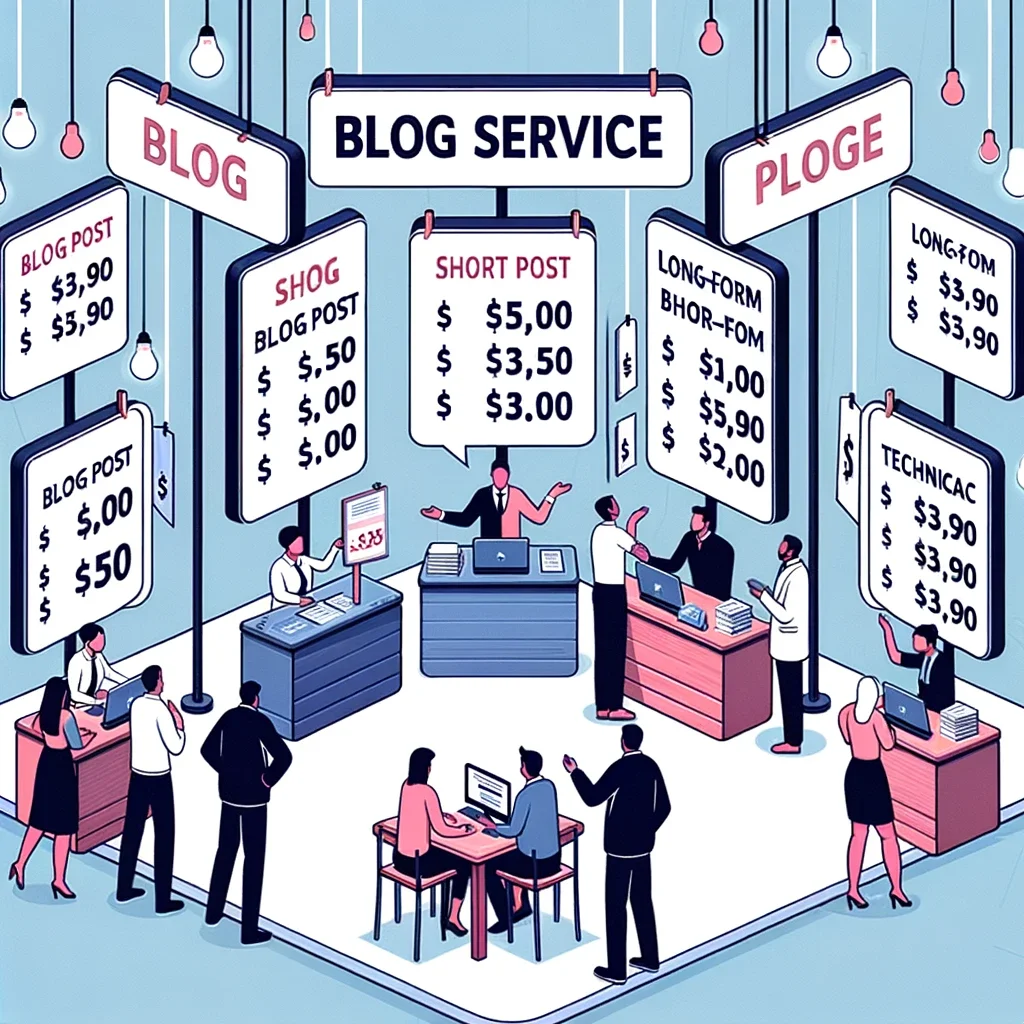Introduction
When you really want to know the price of something, you can never find out what it's worth.
Oscar Wilde
Why Blog Post Pricing Matters
The importance of pricing your blog posts appropriately cannot be overstated. It's a crucial aspect that impacts both your livelihood and your reputation in the industry. Setting the right price ensures that you are compensated fairly for your skills, time, and effort. It also plays a significant role in how clients perceive the quality of your work.
In an industry where rates can vary widely, understanding the nuances of pricing can give you a competitive edge. It's not just about how much you charge, but also about how you present your pricing structure to potential clients. This involves a deep understanding of market rates, the value you offer, and the specific needs of your clients.
Determining Your Worth as a Blogger
Your worth as a blogger is a multi-faceted concept that goes beyond simple metrics like writing speed or years of experience. It encompasses your ability to engage readers, your expertise in a particular niche, and your proficiency in aspects like SEO and social media marketing. Knowing your worth helps you set a price that reflects your skills and the value you bring to a project.
To determine your worth, consider factors like your level of expertise in the subject matter, your writing style, and any additional services you offer such as keyword research, image sourcing, or social media promotion. All of these contribute to your overall value as a blogger.
What This Article Will Cover
This article aims to provide a comprehensive guide to blog post pricing. We will delve into various factors that should influence your pricing strategy, including market research, cost analysis, and specialized services. By the end of this article, you'll have a clearer understanding of how to set fair and profitable rates for your blog posts. How Much to Charge for a Blog Post
How Much to Charge for a Blog Post
| Factor | Description | Example Rates |
|---|---|---|
| Experience Level | Years of experience and expertise in the field | $50 - $200 per post |
| Industry Rates | Average rates in the specific industry or niche | $75 - $250 per post |
| Length of Post | Number of words | $0.10 - $0.50 per word |
| Research Required | Time spent on research and data gathering | + $20 - $50 |
| SEO Optimization | Incorporating keywords, meta descriptions, etc. | + $15 - $30 |
| Visual Content | Adding images, videos, infographics, etc. | + $10 - $40 |
| Social Media Promotion | Promoting the post on social media platforms | + $10 - $25 |
| Revisions | Number of revisions requested by the client | + $10 - $20 per revision |
| Specialized Knowledge | Requires specialized knowledge or technical expertise | + $30 - $100 |
| Urgency | How quickly the client needs the post | + $20 - $50 |
Market Research and Industry Rates

Understanding the Going Rate
Before setting your own rates, it's essential to have a grasp of the going rates in the blogging industry. Understanding the market rate serves as a baseline for your own pricing. Various platforms publish annual reports on freelance writing rates, and these can be a good starting point. However, remember that these are often averages and may not accurately reflect rates in your specific niche or geographic location.
To get a more accurate picture, consider joining freelance writing forums, networking with other bloggers, and directly asking clients about their budgets. This will give you a more nuanced understanding of what clients are willing to pay for the services you offer.
Surveying the Competitive Landscape
Knowing your competition is crucial. Take the time to research what similar bloggers in your niche are charging. This will not only give you an idea of the market rate but also help you identify where you can offer more value. For example, if most bloggers in your niche don't offer SEO optimization but you do, that's a value-added service you can charge for.
Client Expectations and Budgets
Different clients have different expectations and budgets. Corporate clients may be willing to pay more for high-quality, specialized content, while smaller businesses or individual bloggers might have tighter budgets. Understanding your client's expectations and budget constraints is crucial in setting a price that is agreeable to both parties.
It's often helpful to have tiered pricing options to cater to different budgets. For instance, you could offer a basic package for smaller clients and more comprehensive packages that include additional services like keyword research, image sourcing, and social media promotion for larger clients.
Cost Analysis and Overheads
Time is Money: Calculating Your Hourly Rate
One of the most straightforward ways to determine your blog post pricing is by calculating your hourly rate. To do this, you need to consider how much time it typically takes you to complete a blog post from start to finish. This includes research, writing, editing, and any additional tasks like SEO optimization or image sourcing. Once you have an estimate, you can multiply this by your desired hourly rate to get a per-post rate.
Keep in mind that your hourly rate should not only cover your time but also contribute to your overall income goals. Don't forget to account for taxes, health insurance, and other overheads when setting this rate.
Skillset and Expertise: The Value You Bring
Your unique skill set and expertise can significantly influence your blog post pricing. If you have specialized knowledge or skills that are in high demand, you can charge a premium for your services. For example, if you're an expert in a highly technical or specialized field, clients are likely to be willing to pay more for your in-depth expertise.
Operational Costs: Don't Forget the Overheads
When setting your rates, it's crucial to account for operational costs. These can include software subscriptions, hardware costs, and even the electricity to power your workspace. These overheads should be factored into your pricing to ensure you're making a sustainable income.
By taking the time to analyze your costs and overheads, you can set a rate that not only reflects your skills and expertise but also allows you to run a profitable blogging business.
Specialized Services and Upcharges
SEO: More Than Just Writing
In today's digital landscape, SEO (Search Engine Optimization) is more important than ever. If you have the skills to optimize a blog post for search engines, this is an added value that you can charge for. This involves keyword research, meta descriptions, and ensuring the content is easily readable by search engine algorithms. Clients who understand the value of SEO are often willing to pay a premium for this service.
Visual Content: The Impact of Images and Videos
Visual content can greatly enhance a blog post's appeal and effectiveness. If you can source or create relevant images, infographics, or even videos, consider this when setting your rates. Some bloggers charge extra for these services, or they may offer different "packages" that include various types of visual content.
Social Media Promotion: Extending Your Reach
Another specialized service you might offer is social media promotion. If you have a strong social media following, you can charge for sharing the blog post on your channels. This extends the reach of the post and can bring in more traffic, something that's highly valuable to clients.
By considering these specialized services and potential upcharges, you can offer more comprehensive packages to your clients, thereby increasing your earning potential.
Structuring Your Pricing
Per-Word Pricing: The Pros and Cons
One common way to charge for blog posts is on a per-word basis. This method is straightforward and easy for clients to understand. However, it may not always reflect the quality or the effort required for the post. For example, a well-researched, 500-word article that took hours to write might be undervalued if you're charging the same per-word rate as a simpler piece.
Flat Fee: Simplicity and Transparency
Another option is to charge a flat fee for each blog post. This can be advantageous because it's simple and transparent. Clients know exactly what they're getting and for how much. However, you'll need to be clear about what this fee includes. Does it cover revisions? What about the cost of images or other media?
Retainers and Long-Term Contracts: Securing Stability
For ongoing work, you might consider a retainer or long-term contract. This provides some financial stability and builds long-term relationships with clients. It's often a win-win: the client gets a trusted, reliable writer, and you get a steady income stream.
By carefully considering how you structure your pricing, you can find a method that fairly compensates you for your time, skill, and the value you bring to a client's project.
The Art of Negotiation and Contracting
Setting Your Boundaries: What's Non-Negotiable
Before entering any negotiations, it's crucial to know your boundaries and what's non-negotiable for you. Whether it's your minimum rate or the scope of work, having these boundaries set in advance can guide the negotiation process and help you avoid low-ball offers.
The Power of Persuasion: Negotiating Your Worth
Negotiation is an art, and it's one that can significantly affect your income. Understanding the power of persuasion and how to effectively communicate your worth can lead to better rates and more satisfying work relationships. Don't be afraid to showcase your portfolio, discuss your experience, and explain why you're the best fit for the project.
Contracts and Agreements: Seal the Deal Properly
Once you've negotiated terms, it's time to put everything in writing. A well-drafted contract protects both you and the client, outlining what is expected from both parties. Make sure the contract includes payment terms, the scope of work, deadlines, and any other important details.
FAQs
Should I Ever Write for Free or Exposure?
The question of whether to write for free or exposure is a contentious one. While some argue that it can be a good way to get your foot in the door, especially when you're just starting out, others believe that it devalues the profession. The key is to weigh the benefits against the drawbacks. If the exposure could lead to lucrative opportunities down the line, it might be worth considering.
How Do I Handle Difficult Negotiations?
Negotiating your rates can be a challenging process, especially when dealing with difficult clients. Preparation is key. Know your bottom line, be ready to justify your rates with concrete examples of your experience and expertise, and be willing to walk away if the terms are not favorable.
What Are Some Red Flags to Watch Out For?
Be cautious of clients who are unwilling to sign a contract, haggle excessively over rates, or have a history of not paying freelancers on time. These are red flags that could indicate a problematic client.
Conclusion
Striking a Balance: Fair Pricing for You and the Client
The ultimate goal in determining how much to charge for a blog post is to strike a balance between what's fair for you and what's fair for the client. This balance is achieved through careful research, self-assessment, and negotiation. Remember, your skills and time are valuable, and it's important to price them accordingly.
The Ethical Aspects of Pricing
While it's tempting to charge high rates if the market allows, it's also important to consider the ethical aspects of your pricing strategy. Are you providing value that matches your price? Being ethical in your pricing not only builds trust but also encourages long-term relationships with clients.
Final Recommendations and Takeaways
To sum it up, determining how much to charge for a blog post involves a multi-faceted approach that considers market rates, your own skill set and costs, and the specific needs of the client. Always be prepared to negotiate but know your worth and don't be afraid to ask for it.



